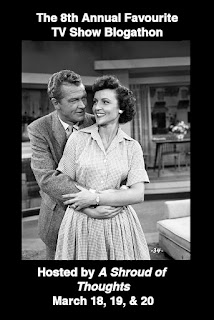Watching a movie starring Fred Astaire and Ginger Rogers is like accepting an invitation to the best party in town. Who doesn't need that in February?
RKO struck gold with the pairing of Astaire and Rogers in support in 1933s Flying Down to Rio where they were a sensation with their wisecracks and their dancing the Carioca. The pair would make nine films together for the studio before the decade was through. In 1934 they were starring in The Gay Divorcee based on the Cole Porter Broadway hit (248 performances) The Gay Divorce. The only connections from the stage to the screen were the star, Fred Astaire, and the song Night and Day.
The abundantly talented Ginger Rogers was in five films released in 1935 and two of them featured her with her most famous co-star, Fred Astaire. In Roberta they supported leads Irene Dunne and Randolph Scott, stealing the show with their acting and appealing dance routines, and in Top Hat their status as one of the movies' greatest teams was established for all-time.
The story of Top Hat was written by Dwight Taylor (Pickup on South Street, I Wake Up Screaming, Follow the Fleet) and, as were five of the great Astaire and Rogers films, directed by Mark Sandrich (So Proudly We Hail, Cockeyed Cavaliers, Holiday Inn). The beautiful black and white cinematography is by David Abel who shot five of the Astaire and Rogers classics. Van Nest Polglase was the set designer on this fabulous film that is one of his six Oscar nominations. The gorgeous gowns were designed by Bernard Newman who was inducted into the Costume Designer's Hall of Fame in 2004.
Edward Everett Horton, Helen Broderick, Eric Blore
Ginger Rogers, Fred Astaire, Erik Rhodes
Dale Tremont (Ginger Rogers) is a model currently in London, England where she crosses paths with American dancer Jerry Travers (Fred Astaire) who is starring in a stage revue being produced by his friend Horace Hardwick (Edward Everett Horton). Jerry is the impulsive sort and falls for Dale immediately and does nothing but annoy the poor girl. You might think that their staying at the same hotel would make smooth the road to true love. Your thinking would be wrong. Through a series of misunderstandings, Dale thinks that Jerry is Horace, and Horace, whom Dale has never met, just happens to be married to Dale's best friend Madge (Helen Broderick). Finding herself attracted to who she thinks is a married man, Dale flees the city to an Italian resort with designer Alberto Beddini (Erik Rhodes).
Dale is Beddini's muse and model. She wears his designs to advertise them to the "smart set". Beddini hopes to make their relationship more permanent through marriage. Madge, already at the resort, is amused by the idea that her husband has been chasing Dale. Horace is in the dark about everything. If Horace didn't have his officious manservant Bates (Eric Blore) to look after him, he'd never get anything done. There will be more shenanigans before our mixed-up lovers get together, and we'll enjoy every antic.
Dale is Beddini's muse and model. She wears his designs to advertise them to the "smart set". Beddini hopes to make their relationship more permanent through marriage. Madge, already at the resort, is amused by the idea that her husband has been chasing Dale. Horace is in the dark about everything. If Horace didn't have his officious manservant Bates (Eric Blore) to look after him, he'd never get anything done. There will be more shenanigans before our mixed-up lovers get together, and we'll enjoy every antic.
The complications are intricate and silly. The dialogue is witty and delivered with panache. The acting ensemble knowingly plays with the perfect light touch to compliment the material. Ginger is a dream in one amazing outfit after another. The cast, director and plot are similar in tone to the successful The Gay Divorcee. Smart folks those movie makers. When something is this good, the audience will always want more.
Ginger Rogers, Irving Berlin, Fred Astaire
Top Hat could and does work very well as a romantic comedy, but it is more than that, it is an Irving Berlin movie and the composer wrote some of his most glorious and ever-lasting songs for the film. Cheek to Cheek may be the song most associated with the Berlin-Astaires-Rogers trio. Its intricacies are beautifully interpreted by the voice of the 20th century, Fred Astaire. What else can you call a man who introduced many of the finest tunes of Gershwin, Porter, Kern and Berlin? The song Top Hat jauntily encapsulates a style, a time and an immortal talent.
Top Hat's 31 Days of Oscar credentials: Nominated for Best Picture (winner - Mutiny on the Bounty), Best Art Direction (winner - The Dark Angel), Best Dance Direction (winner - Broadway Melody of 1937/Folies Bergere de Paris) and Best Original Song, Cheek to Cheek (winner - Lullaby of Broadway)
Top Hat's 31 Days of Oscar credentials: Nominated for Best Picture (winner - Mutiny on the Bounty), Best Art Direction (winner - The Dark Angel), Best Dance Direction (winner - Broadway Melody of 1937/Folies Bergere de Paris) and Best Original Song, Cheek to Cheek (winner - Lullaby of Broadway)
TCM is screening Top Hat on Tuesday, February 3rd at 2:30 am. It may be your first time to the party or you may be a regular guest. In either case, dust off your top hat, white tie and tails, slip on your most elegant gown - the one with the blue feathers - and enjoy!

































